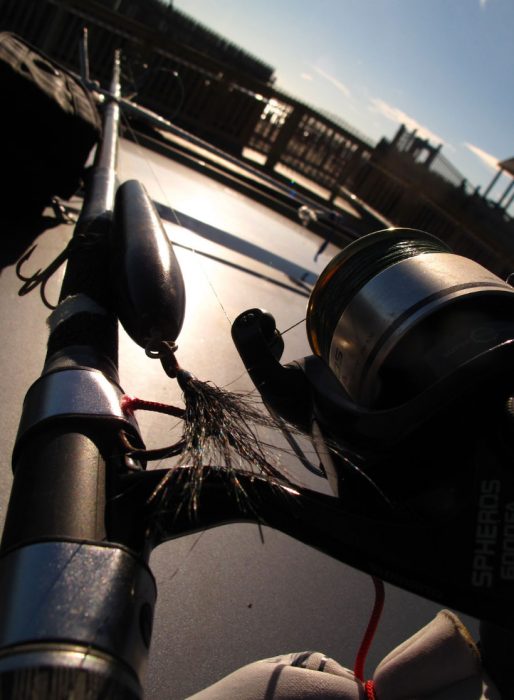by Zach Harvey

For all my efforts to extract the last bits of marrow from the fishing months here in the cold north, I am still dumbfounded here at the end of it—the bones of another year’s bounty along the shore. I suspect the protracted autumn warmth of our new climate patterns have a bit to do with it: When I’m standing in 50-some-degree water and the air temps are hanging tough in the 40s, the last thing I’m thinking is winter. Our depleted rations of daylight since the clock fell back a month ago don’t have much effect on those of us who do most of our line-wetting between sundown and false dawn. More than one recent night, I could easily have convinced myself I was fishing early May.
Still, it’s December, and even the staunchest advocates of the water-temp theories in migration timing start to have trouble convincing themselves that there’s life swimming beneath the end of each cast. The fishless sessions start to pile up. Fifty degrees or no, the water takes on a different look when the fishing has expired—gray-green and almost alarmingly clear. When I’m standing in an inlet and the trebles on my plugs start coming back wearing maple leaves instead of eel grass or that clingy brown snot-weed, it don’t have much trouble dreaming up compelling reasons to miss nights.
That’s been the official story, anyway: at, barring the possibility of some 20-fish schoolie sessions along the ocean beaches, or maybe one more limit of tautog amid diminishing returns on the 90-foot rockpiles, my season is drawing to an unusually abrupt close. Mother Nature’s the boss. Nothing to be done about it.
The reality is something altogether less reasonable or deliberate or credible. Truth is, for at least a decade, I have treated my gear with all the systematic, loving care I typically extend to my left shoe when my nose reveals a glistening mass of recycled Alpo stuck in the treads.
I have never been what you’d call a gear head, spend precious little time combing through tackle catalogs. Some of it I attribute to an attitude I developed over almost two decades working deck (and a common one among seasoned deck apes): You can spend a fortune on gear, but no amount of money will buy you talent. Or, you can turn the idea around: A good fisherman ought to be able to catch fine with any semi-functioning set-up.
For quite a few years I kept my three main all-purpose sticks working via all sorts of duct-tape-and-spackle field maintenance. It was the tail end of August when my luck ran out. In the intervening months, my late-night casting sessions involved an alarming amount of time squinting into bail mechanisms, anti-reverse knobs, drag washers. I ruined two full spools of fresh braid to chipped guide liners, then watched an old, badly delaminated back-up surf rod shed an entire guide’s diamond-wrapped thread (followed by the guide itself.
I leant a friend one of my other newer St. Croix spinning rods and then watched, stunned, as he thwacked the stick off a piling and removed the top two guides and about 6 inches of the blank. at sawed-o 7-footer is now on standby should I ever decide to test my sh- ghting skills against a 1986 Ford Topaz.
Reels? I don’t want to talk about that. My two pet surf reels both left the line-up in the advanced stages of catastrophic failure: My workhorse Penn 450SS now sounds like a solid-brass pepper grinder loaded with BB’s and bits of aluminum foil. The other, a Daiwa that saw zero grand-total maintenance (barring emergency oiling) now features what I like to call a custom “Slip-‘n-Seize-‘n-Snap” Intermittent Drag System that now really only works in “manual override” mode (i.e. cupping the spool).
As I prepare to perform last rites on another year’s rod-and-reeling, I’m pleased to tell you that I’ve found what might be a silver lining beneath this ten-year span of serial neglect. Years ago, after five years learning to play tennis with an unwieldy aluminum racket, I got my first composite model.
Point is, in fishing as in any other activity, if you learn to get the job done when every piece of your gear is working against you, coming back at it with top-shelf equipment inevitably delivers exponential improvement in your game.
Lucky for me, the rod-building racket has made some quantum improvements since I last wandered among the tackle shop racks with a knot of cash in my back pocket. For one thing, current blank construction materials and techniques now let rod designers deliver unprecedented power and sensitivity in dramatically lighter, thinner sticks that balance off perfectly with ultra-compact reels (the latter engineered to hold staggering yardage of braided line).
For a few years now, friends of mine have begun to do everything- -jigging (or chunking) for bluefins, feeling for heavyweight bass, wreck- hopping for big cod or pollock, drifting for fluke or working on scup—with a single set-up.
I’ve long believed that familiarity with your gear (a product of experience) is the best way to refine almost every subset of your technical skills behind the reel. Somewhere between muscle memory, intense focus, and your developing ability to make sense of the cues crackling up the line, you start to catch more, bigger, more o en. And when you’re using a single weapon full-time, the experience piles up much faster than it ever could when a serious multispecies fisherman needed a dozen sticks to get through a month of angling opportunities.
For what it’s worth, if you’re debating a rod and reel as a present for the incoming holidays, consider the many advantages of uncluttering the arsenal with one weapon to handle most of the fishing you’ll encounter in the next fishing year.
by Zach Harvey









